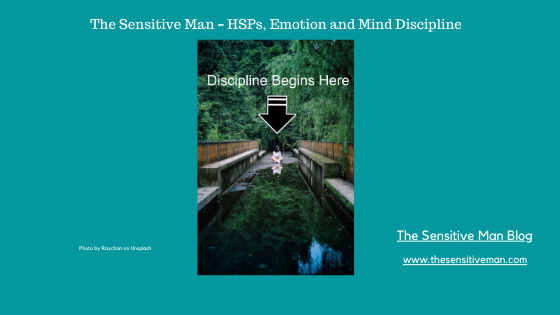|
A Blog about Sensory Processing Sensitivity from the Worldview of a High Sensing Male
One of the big four traits of Highly Sensitive People is the propensity for overstimulation, often referred to as overwhelm. Sensory inputs become too much to handle, and the finely tuned HSP systems begin to shut down or, at the very least, require downtime. This time is essential for HSPs to regroup, recover and restore. All HSPs will experience this at some time or another. Many in difficult work or home environments experience this frequently. For some of us, this overwhelm is embarrassing, especially for HSP males, who struggle with their masculine pride to admit that emotions, environments, and engagements can cause us to go into shutdown mode. We have been socialized to believe that this type of reaction is a sign of weakness-- not being able to tough it out and press on. But can we control overwhelm? Head it off at the pass at the first sign of onset? And more importantly, should we? Is overwhelm a sign of an undisciplined mind? Let’s see. What is overwhelm? What happens to the highly sensitive mind when it reaches overwhelm? Because HSPs process stimuli at a much deeper level both internally and externally, they often get caught in cycles of strong visceral and mental reactions, leading to depletion, exhaustion, and overstimulation. With poor coping skills or lack of support, many HSPs find themselves caught in a vicious cycle of overstimulation, shutdown, and then overstimulation again. This cycle is exceedingly exhausting and leads many HSPs into avoidant or withdrawn behavior. This behavior compounds personal and socially derived stress and stigmatizes the HSP into feeling negative about themselves and their ability to cope. And emotional reaction is often the root cause of overstimulation. Without getting too much in the weeds about the anatomy or dynamics of emotions, emotions play a large part in human behavior, and for HSPs, emotions are our currency. Much has been said about the limbic system, particularly the amygdala, in driving emotional response. The amygdala is most often associated with fear response and plays an essential role in alerting to danger, including fight or flight. However, there appears to be a three-tiered model for the emotional function that works above and below the limbic system or the midbrain. At the base, the brain stem contains a primary stimulus-response adaptive reaction. From there, emotion moves up to the more complex reactivity within the hypothalamus and thalamus, followed by memory and cognition of the limbic/cortex neural networks. Each level represents more complexity of the emotional response to the environment. From an evolutionary standpoint, the continued higher-level function extends and expands the brain functioning not to replace earlier, more superficial structures but to enhance them. The use of memory paired with emotion allows for past experiences reference to determine future action. This apparatus is key to enhancing recall by pairing memory with emotion to provide a more robust memory encoding. This encoding of memory energized by emotion makes recall of important data significant for survival. The use of cortical influence on the limbic system to throttle emotional response signifies the importance of these higher-order facilities to allow, especially in primates, to moderate, simple stimulus-response towards more directed goal-oriented behaviors that may serve a broader and more adaptive reaction. In short, this means that we as humans can use our critical thinking capacity to redirect automatic emotional responses with more directed thoughtful actions. This ability is vital to when thinking about our ability to regulate emotional overwhelm. Emotions may be triggered both bottom-up, which generally follows the stimulus-response model, much of which is reactive and spontaneous, or top-down, a self-created stimulus that causes the rudimentary response of the lower level to fire. This suggests that our emotions can be created automatically and instinctively or through self-initiated and controlled processes. The point is that we can control our emotional response, which leads us to the idea of emotional regulation. The Benefits of Emotional Regulation for HSPs Emotional regulation, which is often advocated by Dr. Aron to alleviate emotional overload, has many benefits for HSPs. Emotional regulation is the ability to respond to the demands of a wide range of human emotions with socially tolerable responses that allow for both spontaneity and restriction of emotion when warranted. It covers a wide range of processes that include feelings, physiological responses, thoughts, and bodily actions. This capacity to regulate our emotions can aid in maintaining clear vision, focused and appropriate responses, and developing a calm mind. Part of the strategy of handling emotions is to allow the emotional experiences to flow through you and not overwhelm you. Understanding that you can override what would appear to be an automatic reaction with a thoughtful strategy will allow you to “flip the bit” in your mind turning from a panicked response to calm and thoughtful action. Putting the attention on the control and not on what would ordinarily be an automatic response. A process model suggests several strategies used for emotional control, not all of which are ideal.
So, as highly emotional creatures, how do we get to the point where emotional regulation is natural and easy for us. It so often seems that we react without much thought to emotional stimulus and create overwhelming situations that drive us to shut down and then downregulate to achieve a sense of calm. This seems quite natural for many HSPs, but is it necessary? Is this just a matter of learning to discipline our minds or, better yet more efficiently use them? How can we train our minds not to overreact? Aside from some of the other strategies suggested above, can we retrain our minds to bypass the emotion => overreaction => overwhelm cycle automatically? In short, I believe we can. One of the first things in changing behaviors is to become mindful of the behavior. Start by looking for triggering events; these usually happen in patterns. What triggers you? We all have our buttons, and to control the reaction, you must first identify the trigger. We do this by observing our patterns. We all have patterns. Humans are notoriously creatures of habit. If you follow the patterns, you will be able to observe the triggers and reactions. Many of our patterns are automatic behaviors, also known as automaticity. These behaviors often operate below conscious awareness and can seem to pop out of nowhere. By being mindful, we can trace back to the trigger and response to find and observe the pattern at beginning of the reaction. The idea is to disrupt the pattern by use of explicit attention by the conscious mind, altering the outcome. The disruption of the pattern breaks off the response, allowing you to deconstruct what happened. Understanding the mechanics, without necessarily exploring the deep roots, will at least give you the ability to create a different state, perhaps, one of calm detachment. Now, aware of the pattern, you can deploy one of the process model strategies suggested or create your own. Deep seeded issues will need to be pursued with a qualified therapist. Still, for everyday emotional problems, this can aid in regulating your emotional responses and even increase your Emotional Intelligence. Learning to perceive, use, understand and manage your emotions can empower you to take control of what we often see as the uncontrollable fire hose of emotional reaction. It may simply be training, control, and discipline. Towards creating the foundation for mindfulness awareness of our emotional patterns, we must first engage in activities that create that calm mind necessary to do self-examination. This state of relaxation is portable and can travel beyond the meditation mat. Each exercise in the real world of calm detachment requires repetition, one of the critical elements of any learning. Practice this in the real world. Seek out situations where you can practice a calm mind in choppy waters. Invoke calmness and observe the flow. Doing this will require your full attention . A study showed that this ability aids in emotional regulation. I highly recommend using neurofeedback training to create a trained pattern of calm and learned resiliency in the brain. A recent study found that the experimental group more easily controlled top-down connectivity as measured by MRI neurofeedback. My personal experiences with neurofeedback systems, such as Neuroptimal from Zengar, on an anecdotal level did increase my brain resilience in stressful situations. As this technology becomes more personal and interactive, this approach is more available to the masses. See my earlier post on readily available brain hacks to promote relaxation. The bottom line is finding your path to greater self-regulation. The Benefits of a Disciplined Mind My top five benefits of a disciplined, self-regulated mind are:
Please share your thoughts in the comment section.
1 Comment
|
AuthorBill Allen currently lives in Bend, Oregon. He is a certified hypnotist and brain training coach at BrainPilots.com. He believes that male sensitivity is not so rare, but it can be confounding for most males living in a culture of masculine insensitivity which teaches boys and men to disconnect from their feelings and emotions. His intent is to use this blog to chronicle his personal journey and share with others. Archives
July 2024
Categories
All
|


 RSS Feed
RSS Feed
